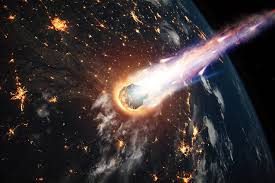
Doomsday may not be far away
Newswire
Islamabad: Boiling oceans and searing air temperatures will render our planet uninhabitable in the distant future, University of East Anglia scientists claimed.
We do at least have time to book our tickets to Mars or any of the other 1,000 “suitable” planets detected so far, according to Andrew Rushby of the University of East Anglia
Rushby said: “We estimate that Earth will cease to be habitable somewhere between 1.75 and 3.25 billion years from now. After this point, Earth will be in the ‘hot zone’ of the sun, with temperatures so high that the seas would evaporate. We would see a catastrophic and terminal extinction event for all life.
Readers who have set their doomsday clock for a billion years in the future might want to move the hour hand a little closer – several scientists have pointed out other threats which could bring apocalypse to our planet far more quickly. Many of them, were, of course, designed by us.
Astronomer Royal Martin Rees predicted that by 2020, one million people would had died in a single instance of “bio-terror – or bio-error”.
“Biotechnology is plainly advancing rapidly, there will be thousands-even millions-of people with the capability to cause a catastrophic biological disaster,” Rees said. “My concern is not only organized terrorist groups, but individual weirdos with the mindset of the people who now design computer viruses.”
Controversy raged in 2011 “mutant” strains of the H5N1 bird flu raged as labs engineered “new” viruses – to defend against them.
Paul Keim, chairman of U.S National Science Advisory Board for Biosecurity (NSABB) said: ‘I can’t think of another pathogenic organism that is as scary as this one. I don’t think anthrax is scary at all compared to this.’
In America, enthusiasts calling themselves “biohackers” race to engineer new strains of bacteria – and perhaps even new forms of life.
The field ‘synthetic biology’ came into being in 2010 when a scientist added synthetic DNA to a bacteria cell to create a ‘new’ life form.
An Oxford ethicist warned that it opened the door to ‘the most powerful bioweapons imaginable’.
Drones and other automated weapons systems are common on the battlefield – and even for police surveillance. But Human Rights Watch warn that Terminator-style robots – which can “decide” to kill – will be feasible in decades.
Human Rights watch claims several governments are working on the technology now.
The U.S government in particular has admitted to working towards robotic weapons systems with ‘total autonomy’.
“There is an ongoing push to increase UGV – unmanned ground vehicle – autonomy, with an ultimate goal of full autonomy,” said a U.S military report in 2011.
A US Air Force report in 2009 said, “Increasingly humans will no longer be ‘in the loop’ but rather ‘on the loop’—monitoring the execution of certain decisions.
“Simultaneously, advances in AI will enable systems to make combat decisions without necessarily requiring human input.”
When American government representatives asked NASA head Charles Boden what the best response to a large asteroid headed for New York City would be, his answer was simple: “Pray”.
NASA claims to have detected upwards of 97% of the “planet killer” asteroids in the solar system – objects six or seven miles wide, similar to the ones which killed the dinosaurs.
We should have warning if such an object approached, but there are currently no technologies which could stop it.
Media reports often focus on “mid-sized” asteroids, which would destroy a city on impact – but the destructive power of a “planet killer” is difficult to even imagine.
“Sixty-five million years ago, the dinosaurs had a bad day,” says Phil Plait – the writer of the Bad Astronomy blog, and a former Hubble scientist, speaking at TED.
Plait said that the entire Cold War arsenal of nuclear weapons would have amounted to a millionth of the power of the explosion that wiped out the dinosaurs.
Solar flares and coronal mass ejections blast matter into space, and can disrupt satellites – but our atmosphere shields us from much of their effects.
But they can vary widely in size – in 1859, a geomagnetic storm, named The Carrington Event, destroyed telegraph lines, and lit up the skies so brightly people could read at night.
A Lloyds study in 2013 predicted that the effects on our wired society would be far, far worse- costing at least £1.67 trillion, and devastating transport, communication, finance and even food supplies due to the lack of refrigeration.
“We live in a cyber cocoon enveloping the Earth. Imagine what the consequences might be,’ Daniel Baker, of the University of Colorado’s Laboratory for Atmospheric and Space Physics, said in an interview with National Geographic.
‘Every time you purchase a gallon of gas with your credit card, that’s a satellite transaction.
‘Imagine large cities without power for a week, a month, or a year. The losses could be $1 to $2 trillion, and the effects could be felt for years.’
